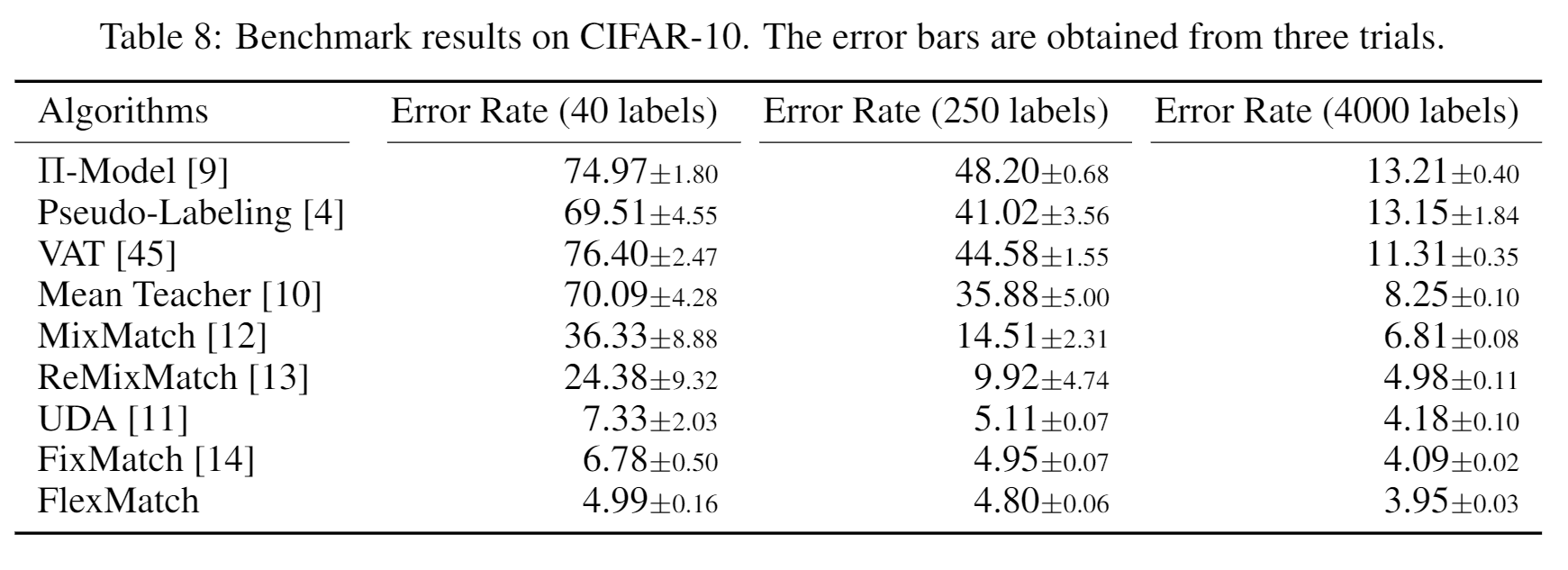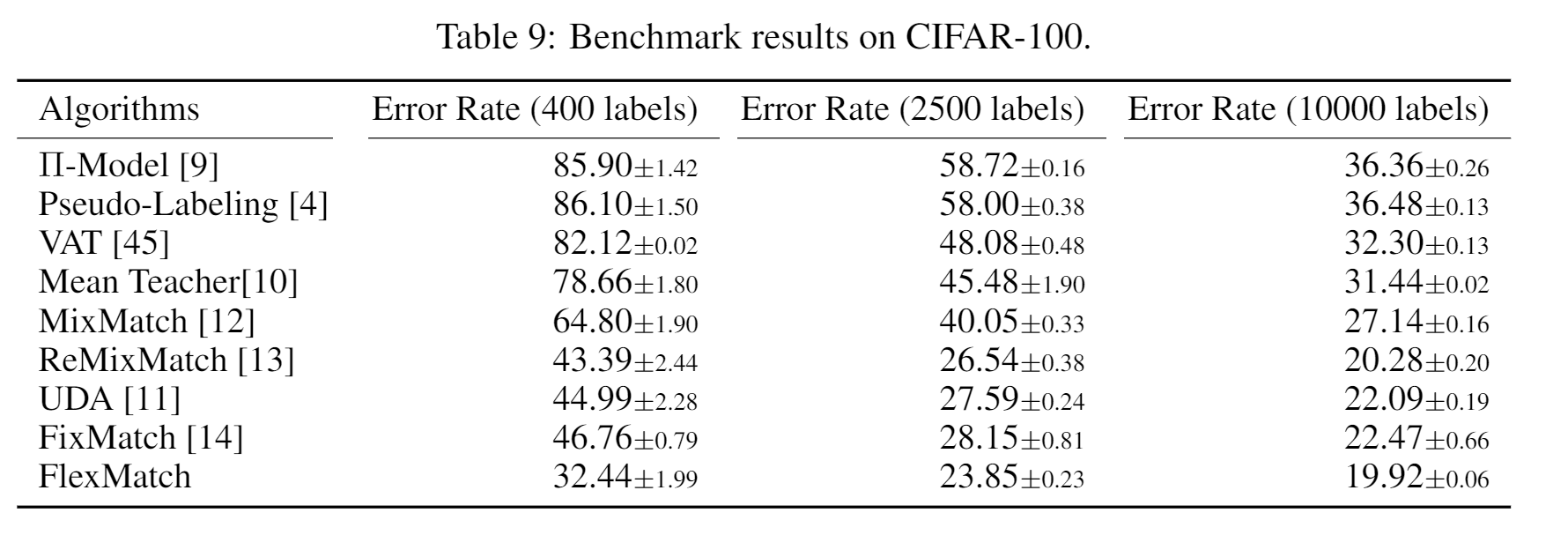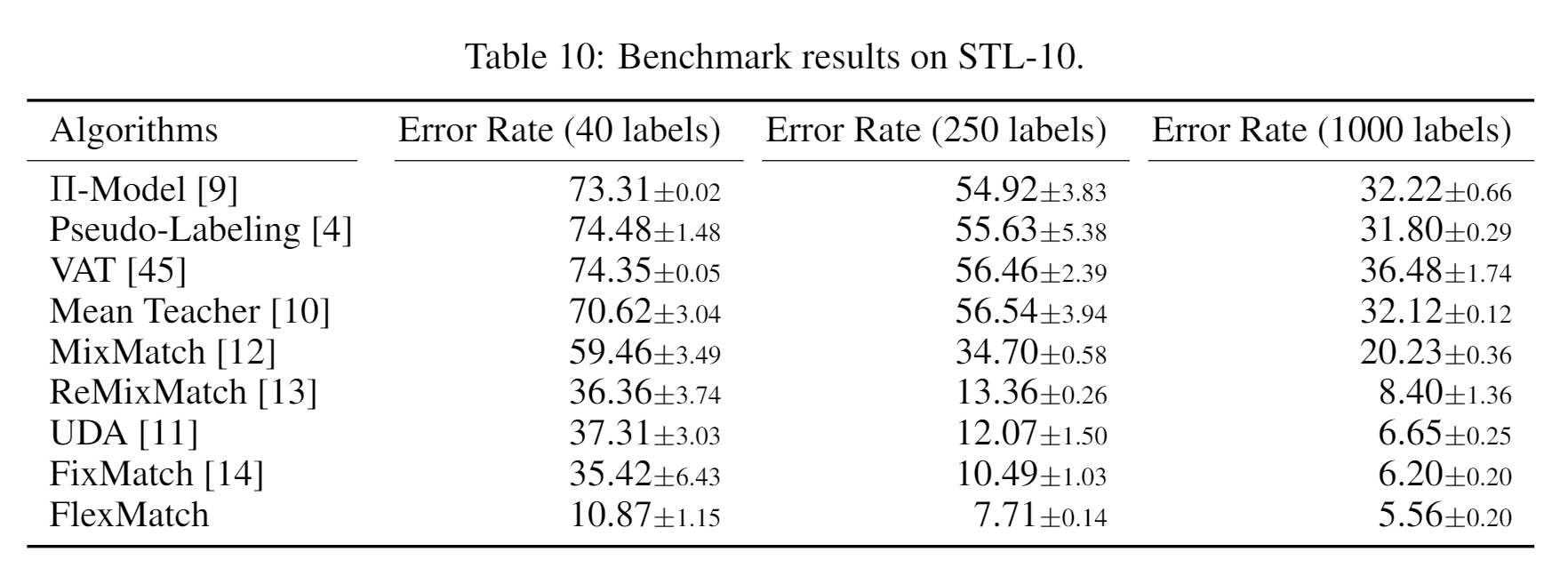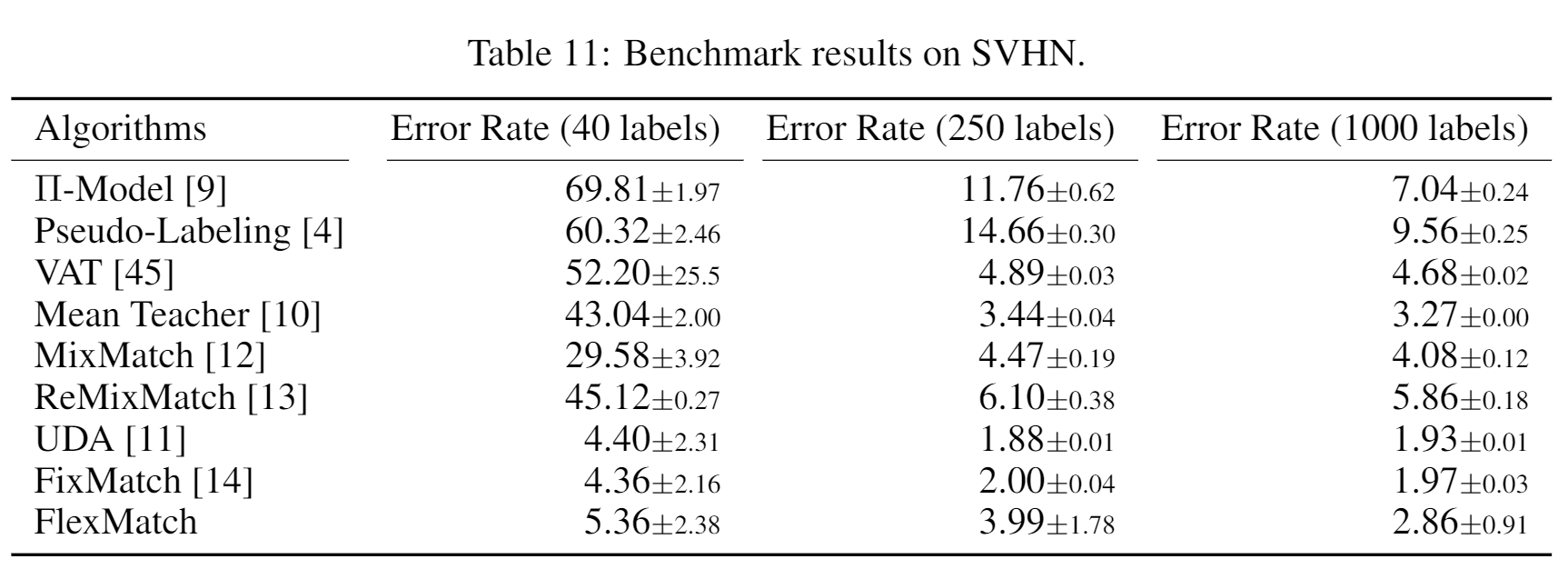- We are reorganizing codes and rerunning experiments to make sure the reproducibility of the results. So please pay attention to our updates.
- If you want to join TorchSSL team, please e-mail Yidong Wang (646842131@qq.com; yidongwang37@gmail.com) for more information. We plan to add more SSL algorithms and expand TorchSSL from CV to NLP and Speech.
An all-in-one toolkit based on PyTorch for semi-supervised learning (SSL). We implmented 9 popular SSL algorithms to enable fair comparison and boost the development of SSL algorithms.
FlexMatch: Boosting Semi-Supervised Learning with Curriculum Pseudo Labeling(https://arxiv.org/abs/2110.08263)
We support fully supervised training + 9 popular SSL algorithms as listed below:
- Pi-Model [1]
- MeanTeacher [2]
- Pseudo-Label [3]
- VAT [4]
- MixMatch [5]
- UDA [6]
- ReMixMatch [7]
- FixMatch [8]
- FlexMatch [9]
Besides, we implement our Curriculum Pseudo Labeling (CPL) method for Pseudo-Label (Flex-Pseudo-Label) and UDA (Flex-UDA).
We support 5 popular datasets in SSL research as listed below:
- CIFAR-10
- CIFAR-100
- STL-10
- SVHN
- ImageNet
- Prepare conda
- Run
conda env create -f environment.yml
It is convenient to perform experiment with TorchSSL. For example, if you want to perform FlexMatch algorithm:
- Modify the config file in
config/flexmatch/flexmatch.yamlas you need - Run
python flexmatch.py --c config/flexmatch/flexmatch.yaml
If you want to write your own algorithm, please follow the following steps:
- Create a directory for your algorithm, e.g.,
SSL, write your own model fileSSl/SSL.pyin it. - Write the training file in
SSL.py - Write the config file in
config/SSL/SSL.yaml
If you think this toolkit or the results are helpful to you and your research, please cite our paper:
@article{zhang2021flexmatch},
title={FlexMatch: Boosting Semi-supervised Learning with Curriculum Pseudo Labeling},
author={Zhang, Bowen and Wang, Yidong and Hou, Wenxin and Wu, Hao and Wang, Jindong and Okumura, Manabu and Shinozaki, Takahiro},
booktitle={Neural Information Processing Systems (NeurIPS)},
year={2021}
}
Yidong Wang1, Hao Wu2, Bowen Zhang1, Wenxin Hou1,3, Yuhao Chen4 Jindong Wang3
Shinozaki Lab1 http://www.ts.ip.titech.ac.jp/
Okumura Lab2 http://lr-www.pi.titech.ac.jp/wp/
Microsoft Research Asia3
Megvii4
[1] Antti Rasmus, Harri Valpola, Mikko Honkala, Mathias Berglund, and Tapani Raiko. Semi-supervised learning with ladder networks. InNeurIPS, pages 3546–3554, 2015.
[2] Antti Tarvainen and Harri Valpola. Mean teachers are better role models: Weight-averagedconsistency targets improve semi-supervised deep learning results. InNeurIPS, pages 1195–1204, 2017.
[3] Dong-Hyun Lee et al. Pseudo-label: The simple and efficient semi-supervised learning methodfor deep neural networks. InWorkshop on challenges in representation learning, ICML,volume 3, 2013.
[4] Takeru Miyato, Shin-ichi Maeda, Masanori Koyama, and Shin Ishii. Virtual adversarial training:a regularization method for supervised and semi-supervised learning.IEEE TPAMI, 41(8):1979–1993, 2018.
[5] David Berthelot, Nicholas Carlini, Ian Goodfellow, Nicolas Papernot, Avital Oliver, and ColinRaffel. Mixmatch: A holistic approach to semi-supervised learning.NeurIPS, page 5050–5060,2019.
[6] Qizhe Xie, Zihang Dai, Eduard Hovy, Thang Luong, and Quoc Le. Unsupervised data augmen-tation for consistency training.NeurIPS, 33, 2020.
[7] David Berthelot, Nicholas Carlini, Ekin D Cubuk, Alex Kurakin, Kihyuk Sohn, Han Zhang,and Colin Raffel. Remixmatch: Semi-supervised learning with distribution matching andaugmentation anchoring. InICLR, 2019.
[8] Kihyuk Sohn, David Berthelot, Nicholas Carlini, Zizhao Zhang, Han Zhang, Colin A Raf-fel, Ekin Dogus Cubuk, Alexey Kurakin, and Chun-Liang Li. Fixmatch: Simplifying semi-supervised learning with consistency and confidence.NeurIPS, 33, 2020.
[9] Bowen Zhang, Yidong Wang, Wenxin Hou, Hao wu, Jindong Wang, Okumura Manabu, and Shinozaki Takahiro. FlexMatch: Boosting Semi-Supervised Learning with Curriculum Pseudo Labeling. NeurIPS, 2021.




